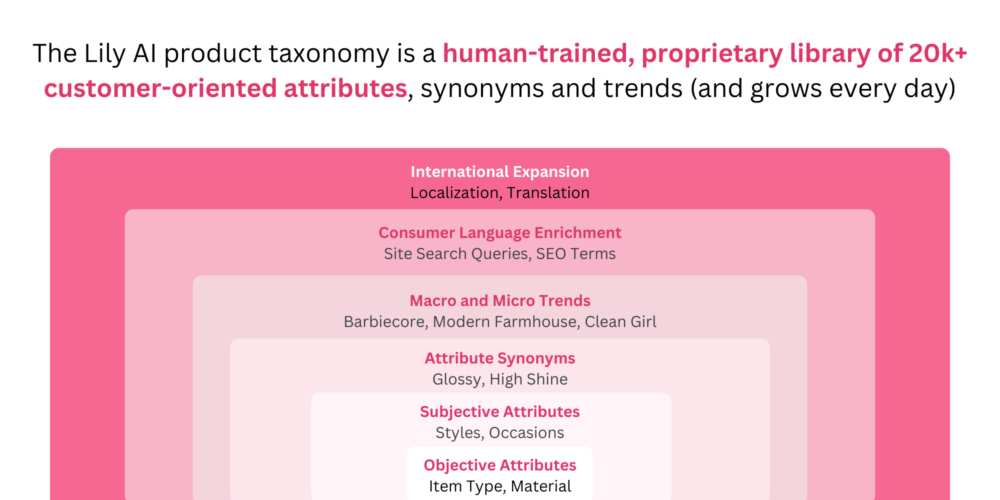Key Takeaways
- Rich product attributes directly improve product discovery and conversion.
- Natural language terms reflect how customers actually search and shop.
- AI-driven attribution replaces manual tagging with speed and scale.
In the AI Discovery Era, you can’t afford to let PDPs and product feeds contain only a handful of basic, industry-jargon-oriented, merchant-centric attributes.
Yet chances are, your product attribute data looks like this:
|
|
|
|
|
|
|
And that’s it.
Despite the need to optimize product content for site search, search engines, AI answer engines, Agentic AI, Google and Meta Shopping Ads, and more, retailers have historically underinvested in their product data. Why? Enriching product data with rich, detailed, and natural language product attributes is complex and resource-intensive, especially for large fashion, home, and beauty catalogs.
Let’s explore why product attribute data is a massive yet mission-critical investment, and why it’s the ideal use case for AI.
What Are Product Attributes?
Each item sold by a brand, retailer, or marketplace has a unique set of features. To the simplest degree, these are the product’s attributes. They are the building blocks for product titles, descriptions, details, highlights and more, and are an important first step towards dynamic Product Content Optimization (PCO).
Product attributes can describe objectively tangible, physical aspects of a product, including embellishments, fits, fabrics, colors, materials, patterns, closures, and more. They can also describe intangible or subjective aspects of a product, such as its style, the occasion or special occasion it’s meant for, or a new trend it perfectly aligns with, and of course, all the synonyms for each variation to account for generational and geographic nuances.

Including this detailed information within a product listing, either on the PDP or in a product feed, makes that item more discoverable and understandable to humans and bots alike.
Why Do Product Attributes Fall Short?
Often, product attributes resemble the simple bulleted list above. Furthermore, many retailers use a merchant-focused language to describe their products, which doesn’t always connect with consumers and can sometimes confuse them.
Product attributes typically originate from manufacturers or brands, and that information is sent on to retailers or marketplaces, where items are listed for sale. This process leaves much room for error, inconsistencies, misattributions, and blank fields. Since it is entirely merchant-focused, however, many products are attributed with descriptive words and phrases that only merchants can understand.
Last but not least, while attributes shouldn’t only reflect “merchant speak”, they do need to accurately reflect the brand. It’s critical that words and definitions for each product attribute must also align with a brand’s taxonomy and guidelines.

How Does Lily AI Approach Product Attribution?
Lily AI’s retail AI suite harnesses a suite of generative AI, computer vision, natural language processing, and machine and deep learning to automatically generate the highest-performing and most customer-centric product attribution available.
Lily’s AI handles product attribution with depth and ease. Its extensive taxonomy covers a multitude of ways consumers speak, including a dynamic taxonomy of customer-oriented product attributes, synonyms, and trends.

Lily AI adds high-performing product attributes during item setup and product onboarding. These attributes are rich and in-depth, including new trends, styles, and categories, such as the following examples:
- Descriptive qualities like nuanced fit of sleeves, back coverage, and color family.
- Synonyms like “thin straps” and “spaghetti straps.”
- Subjective attributes, like trends, styles, and occasions, like “boho chic mini dress.”

In Summary
Retailers need structured, detailed product attributes to drive better performance across search and discovery. However, most product catalogs are still hindered by retail industry jargon and contain thin, inaccurate, or inconsistent data.
Lily AI transforms raw product data into enriched, channel-optimized attributes using AI trained on how customers actually search. With a foundation of rich, natural language-based attribution, brands can harness Product Content Optimization (PCO) to dynamically improve brand visibility across SEO, AEO, and GEO, maximize clicks and web traffic, optimize shopping ads, improve on-site search, and drive measurable revenue growth.
